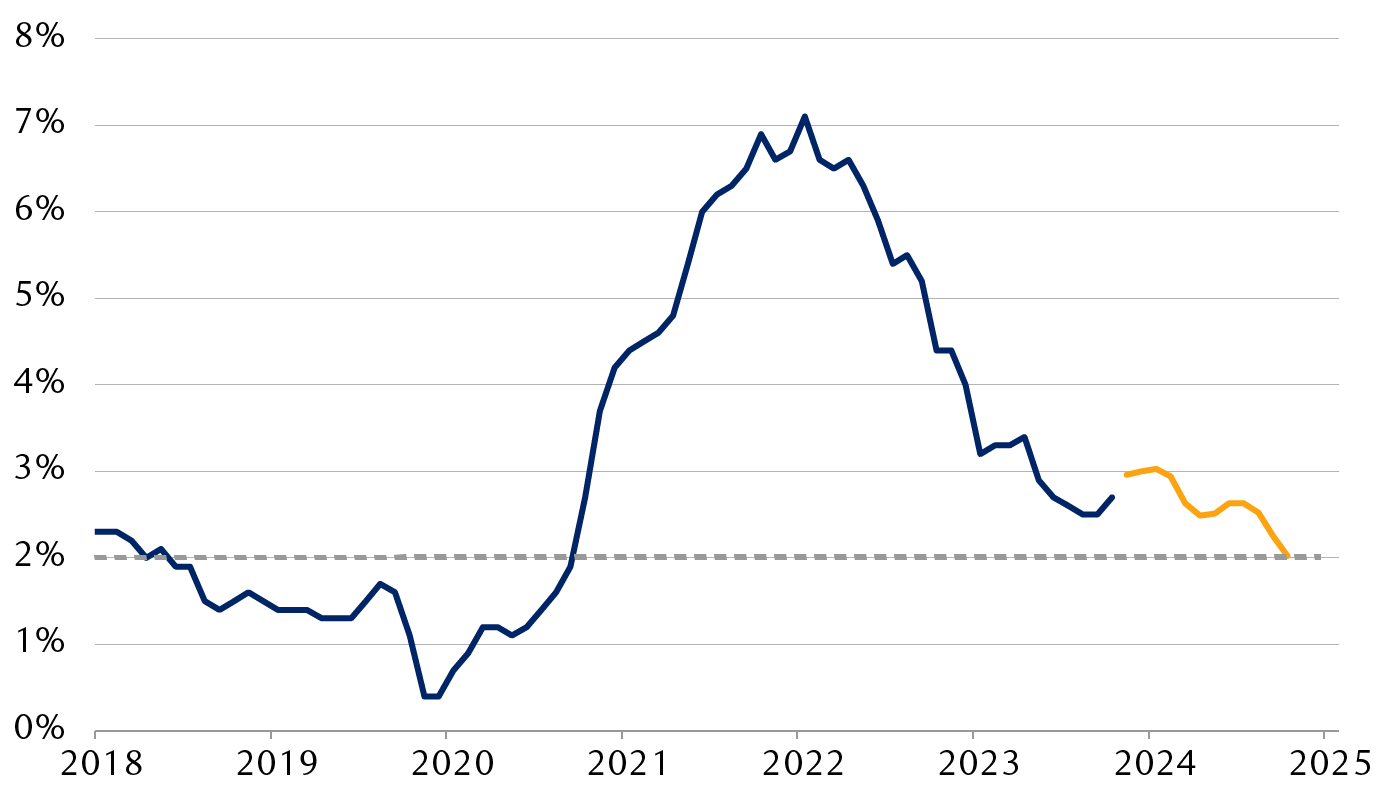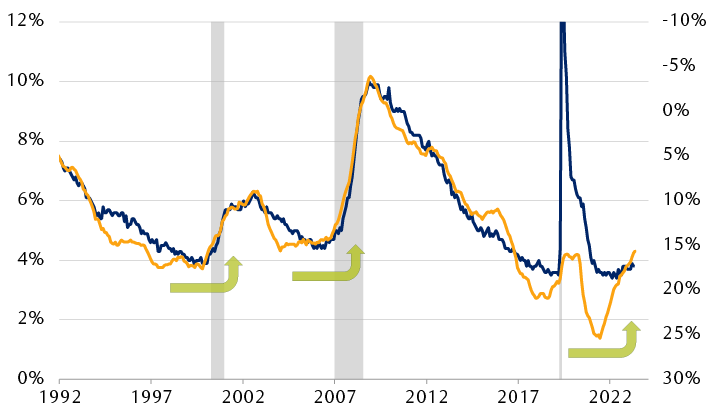For the sixth meeting in a row, the Federal Reserve held interest rates steady at a 5.25 percent to 5.50 percent target range, as expected by all analysts surveyed by Bloomberg. Given recent economic and inflation data, markets have known—and priced—the reality that near-term rate cuts are off the table for the Fed. All markets wanted answered at this meeting was whether rate hikes were back on it.
Though markets at no point this year have taken seriously the idea that the next move by the Fed could be a rate hike, (most implied probabilities based on market pricing have been less than five percent), it has been a lingering risk and a key source of recent fixed income, equity, and currency market volatility.
While Fed Chair Jerome Powell stopped short of explicitly refusing to hike rates again, simply characterizing such a move as “unlikely,” his comments were arguably more dovish than broadly anticipated with the key takeaway that the Fed still looks to be walking down the path toward rate cuts and remains likely to reach that point sometime this year.
If there was one paragraph from Powell’s prepared remarks that caught our attention, and was newly added from the March meeting, it was this:
“We have stated that we do not expect it will be appropriate to reduce the target range for the federal funds rate until we have gained greater confidence that inflation is moving sustainably toward two percent. So far this year, the data have not given us that greater confidence. In particular, and as I noted earlier, readings on inflation have come in above expectations. It is likely that gaining such greater confidence will take longer than previously expected. We are prepared to maintain the current target range for the federal funds rate for as long as appropriate. We are also prepared to respond to an unexpected weakening in the labor market. ”
The addition of that language wasn’t surprising—we expected the Fed would need to acknowledge recent elevated inflation data and that it had likely delayed any prospects for near-term rate cuts. The Fed certainly remains attentive to inflation and related risks. But as the first chart shows, markets and traders—which have had a better track record than economists in recent years—continue to price the idea that the recent inflation uptick should ultimately be modest and short-lived.
Market pricing shows expectation that inflation progress will stall, but only temporarily

The line chart shows the Fed's preferred measure of inflation, Personal Consumptiown Expenditures (PCE), since 2018 and its implied path over the next year based on the pricing of Consumer Price Index (CPI) inflation swaps. Market pricing indicates an expectation that inflation could rise to an annual rate of 3.0% in upcoming months, before fading again and ultimately reaching the Fed's 2% target in early 2025.
Source - RBC Wealth Management, Bloomberg; market-implied inflation path based on CPI swaps; 45 basis points subtracted from Consumer Price Index (CPI) to estimate PCE inflation equivalent
But the last sentence of Powell’s statement is a bit curious. Instead of adding a final sentence that was prepared to respond if inflation continues to move higher, the focus was immediately shifted to potentially responding to a weaker labor market. Perhaps it was little more than stating the obvious, but why even add it at all?
Balance of risks
On the surface, it suggests that the bias remains toward easing policy at the Fed, and that it is still aiming to achieve a soft economic landing. Put differently, higher inflation won’t mean higher rates, but lower employment will mean lower rates.
But with the latest jobs report for April scheduled to be released May 3, the timing is at a minimum somewhat curious. We certainly don’t think there’s any actual signal there, Powell has stated in the past that he receives key economic data along with everyone else, but it does speak to the broader concerns about the labor market that have been percolating over the past year.
To be sure, the jobs report is expected to show yet another strong month of employment gains. RBC Capital Markets is looking for nonfarm payrolls to rise by 267,000 and for the unemployment rate to hold flat at 3.8 percent. But that 3.8 percent has been trending higher since the 3.4 percent low in April 2023. Labor markets rarely deteriorate sharply, typically it’s a slow turn that eventually builds on itself.
So, has the labor market turned? One metric we tend to track closely is the hiring plans index from the monthly NFIB Small Business Jobs Report. As the second chart shows, it has a strong correlation with the unemployment rate. In April, the percentage of small businesses planning to hire was just 12 percent, with an average of 16 percent over the past year. Both are the lowest levels since the depths of the pandemic, and at levels consistent with past recessions, while being consistent with an unemployment rate north of four percent.
With fewer small businesses planning to hire, is labor market weakness ahead?
U.S. small business hiring plans

The line chart shows the reported hiring plans of U.S. small businesses relative to the U.S. unemployment rate. Since peaking above 25% in 2021, the number of businesses reporting plans to hire has dropped to the lowest level since 2018, at around 16% currently. Following the peak in unemployment during the pandemic in 2020, the unemployment rate fell rapidly to under four percent in early 2022, where it remains. The chart highlights three periods during which plans to hire decreased, starting in 2001, 2007, and 2022.
Source - RBC Wealth Management, Bloomberg, National Federation of Independent Business; shows one-year rolling average of businesses reporting intent to hire
Like many economic indicators that have been distorted in a post-pandemic world, it could just be normalization. Hiring plans reached a record high in 2021, so the recent decline could be little more than a normalization, simply reflecting that labor markets are tight and there just isn’t much hiring left to be done. But it has now marked a sustained change in trend, and certainly bears watching.
We know where the ceiling is, where’s the floor?
Even though the Fed has left short-term rates steady since last July, longer-term Treasury yields have once again run higher, renewing fears about how high yields can go. Since the start of the year, the benchmark 10-year Treasury yield has risen by about 70 basis points to 4.60 percent, having peaked at 4.70 percent in April, though that remains below the 2023 high of five percent. Mortgage rates—which are more sensitive to the 10-year than the Fed’s policy rate—have risen in kind to about 7.50 percent from 6.90 percent. In some sense, markets are doing the Fed’s job for it, another reason policymakers can afford to be patient still, and why the Fed might not have to raise policy rates.
But with the Fed downplaying the possibility of further rate hikes, and with markets still pricing in a modest three rate cuts over the next 12 months, we think investors can begin to stop worrying about higher rates. In our view, Treasury yields could now level out around current levels. That said, absent a material deterioration, the floor likely remains above four percent for the 10-year Treasury yield this year.
Fed-related risk isn’t off the radar for markets even if rate cuts aren’t on the horizon—each major economic data point will continue to drive cut timing expectations—but with ever-growing evidence that the Fed is truly on hold, and that any move will still likely be lower, fixed income investors should stay focused on locking in yields, and for gradually longer terms.
